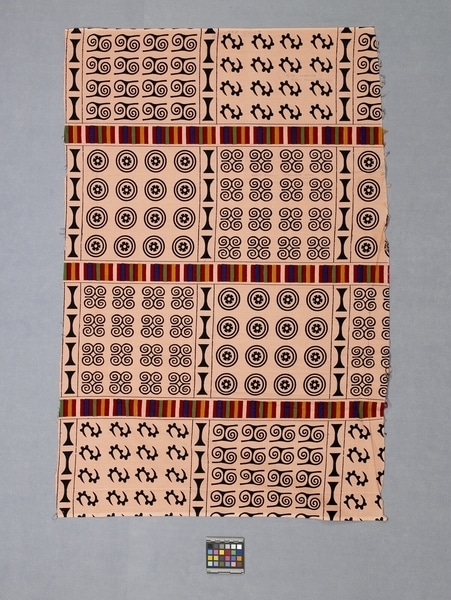Adinkra Cloth Item Number: K2.455 a from the MOA: University of British Columbia

Description
Rectangular shaped cotton textile consisting of eight complete and four incomplete pattern squares divided vertically by repeating vertical bars, and horizontally by red, blue, green and pink repeating stripes. There are three different designs all in black on a pink ground. Written in blue pen at the top is ‘Adinkra Cloth’. The top right square has an s-shaped motif with ‘Gye Nyame’ – God’s Omnipotence noted. Below that is square with a circular motif with ‘Ram’s Horns – Strength thru wisdom’ written. The edges are raw.
History Of Use
In Ghana men wear cloth decorated with Adinkra symbols as wraps. Similar symbols were also traditionally used in decorating ceramics and house facades. The symbols were connected to the Asante, a Twi-speaking people, part of the larger Akan ethnicity. Their culture flourished and developed in relation to their capital city, Kumasi, in what is now Ghana. Kumasi became the centre of the Asante Empire at the end of the 17th century. Adinkra cloth was originally reserved for the Asante aristocracy. Producing it was both labour-intensive and expensive, and interpreting the Adinkra symbols required a high level of visual literacy. Most contemporary Adinkra cloth is now made from industrially milled cotton, printed using traditional processes.
Iconographic Meaning
The four different characters stamped on this cloth are: (top left in photo) Gyawu Aitkoo, “Gyawu’s head,” Gyawu was a rival general vanquished by the legendary king Adinkra, who originated the symbols; (top right) Gye Nambe, “Fearing none except God,” particularly God’s omnipotence and potential plan for the speaker; (2nd row left) Adinkra Ba Apau, "Son of Adinkrahene,” the son of the king Adinkra, who fought Gyawu and brought Adinkra to the Asante; and (2nd row right) Dwanimen, “Ram's horns,” representing strength and humility.
Specific Techniques
A bolt of cotton is laid upon a length of foam on top of a wooden board. Rocks and small nails are placed along the fabric to hold it in place and keep the fabric taut. A comb is dipped into the ink and then pulled across the fabric to demarcate areas to be printed. Stamps (e.g. K2.455 a-g) are chosen by the stamper or the person who has commissioned the piece. Most often one area contains repetitions of one symbol, but a small number can be selected in to repeat. The stamp is then dipped in ink, with excess is shaken off away from the fabric. The stamp is rocked gently from one edge to the other for each press to the fabric. The stamp is redipped into the ink before each reapplication. Kente strips are sometimes sewn in between strips or swathes of Adinkra printed cloth.
Item History
- Made in Ghana between 1970 and 1974
- Collected between 1971 and 1974
- Owned by Dugal Macgregor and Sue Macgregor before September 27, 1974
- Received from Dugal Macgregor (Donor) and Sue Macgregor (Donor) on September 27, 1974
What
- Name
- Adinkra Cloth
- Identification Number
- K2.455 a
- Type of Item
- cloth
- Material
- cotton fibre, ink ? and dye
- Overall
- height 106.7 cm, width 71.1 cm
Who
- Culture
- Asante
- Previous Owner
- Dugal Macgregor and Sue Macgregor
- Received from
- Dugal Macgregor (Donor) and Sue Macgregor (Donor)
Where
- Holding Institution
- MOA: University of British Columbia
- Made in
- Ghana
When
- Creation Date
- between 1970 and 1974
- Collection Date
- between 1971 and 1974
- Ownership Date
- before September 27, 1974
- Acquisition Date
- on September 27, 1974
Other
- Item Classes
- textiles
- Condition
- good
- Current Location
- Case 100
- Accession Number
- 0265/0008 a